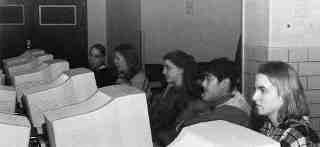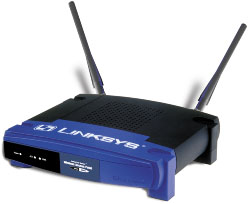Academic Libraries in the Digital Age
Barak A. Pearlmutter
Manifesto
The library should be where (physical) books and journals are
collected. The (physical) books and journals people want should be
available. They should be easy to find, and the library should be a
pleasant and quiet place to read them. The librarians should help
people find the books and journals.
Anything else - especially computers in anything other than a
cataloging role - is a waste of resources, and in the end detracts
from the library's performance of its rightful mission.
Computers have very different needs from books. Access to computers,
and to documents stored on the Internet, can be better provided
outside the structure of a library.
Danger Signs
 Mildew and leaky roofs and termites and censors are serious, but
university libraries face a more insidious threat.
Mildew and leaky roofs and termites and censors are serious, but
university libraries face a more insidious threat.
Advancing technological aspects of libraries and promoting
lifelong learning are synergistic values.*
When a librarian starts spouting crap like that, it's time to find
someone else to steward the collection.
The Enemy of Books: Librarians with Computer Envy
 Librarians are trained to deal with technologies that move slowly, and
that require centralized administration. Namely, physical documents.
They have preserved information for thousands of years, and it is no
exaggeration to say that we owe our civilization more to countless
ranks of anonymous librarians than to brilliant scientists and
engineers. But this long-term stable view intrinsic to the library is
at odds with the fluid and ephemeral nature of computer technology,
which advances in sudden spurts. For this reason, libraries are in
general ill equipped to provide computer access services in an
efficient and affordable fashion. Consider the simple computer card
catalog. It is an example of extremely crummy computer technology:
hard to use, old, inflexible, expensive, ugly, slow, clunky, error
prone, intimidating. If librarians fill their libraries with computer
pods, their whole libraries will look that way.
Librarians are trained to deal with technologies that move slowly, and
that require centralized administration. Namely, physical documents.
They have preserved information for thousands of years, and it is no
exaggeration to say that we owe our civilization more to countless
ranks of anonymous librarians than to brilliant scientists and
engineers. But this long-term stable view intrinsic to the library is
at odds with the fluid and ephemeral nature of computer technology,
which advances in sudden spurts. For this reason, libraries are in
general ill equipped to provide computer access services in an
efficient and affordable fashion. Consider the simple computer card
catalog. It is an example of extremely crummy computer technology:
hard to use, old, inflexible, expensive, ugly, slow, clunky, error
prone, intimidating. If librarians fill their libraries with computer
pods, their whole libraries will look that way.

 Today, as I write this, in late 2001, many libraries are busy
discarding portions of their collection, and revamping reading rooms,
to make room for desktop computer workstations which will provide
their patrons with Internet access, and through it access to online
documents. Today, in late 2001!!! Right now, many students have
laptops. In a few years, they will all have portable computers.
Spending large amounts of money to turn beautiful libraries into ugly
loud computer pods is nuts; in a couple years all the patrons will
have portables, and all buildings on campus (yes including even the
main library) will provide public wireless Internet access using
inexpensive and unobtrusive wireless access points. Computer pods
replacing reading rooms today will enjoy a useful lifetime of a few
years, at most.
Today, as I write this, in late 2001, many libraries are busy
discarding portions of their collection, and revamping reading rooms,
to make room for desktop computer workstations which will provide
their patrons with Internet access, and through it access to online
documents. Today, in late 2001!!! Right now, many students have
laptops. In a few years, they will all have portable computers.
Spending large amounts of money to turn beautiful libraries into ugly
loud computer pods is nuts; in a couple years all the patrons will
have portables, and all buildings on campus (yes including even the
main library) will provide public wireless Internet access using
inexpensive and unobtrusive wireless access points. Computer pods
replacing reading rooms today will enjoy a useful lifetime of a few
years, at most.
Librarians are not specialists in the appropriate use of computer
technology, and are unequipped to forecast technology's future. But
many have computer envy! They want their library to be chock full of
great big beige computers, with loud fans and enormous color monitors,
humming and whirring and flashing their screen savers. Who cares
about musty old books and a quiet place to read them, or mahogany
benches and tasteful architecture? How boring and old fashioned.
What Makes Sense Today
If Internet access is to be retrofittted to a traditional academic
library, the best way to do it today (late 2001) is with laptops and
wireless ethernet. By "best" I mean least disruptive, most cost
effective, least expensive, most flexible, least obtrusive, most
useful.


 One can purchase a bunch of two-year-old laptops for use by library
patrons - perfectly serviceable mint condition laptops mind you - for
under $500/laptop, today. Wireless access points with a range of 100m
cost under $200, today. PCMCIA wireless ethernet cards cost under
$100, today. If a library wants to provide Internet access, it can
set up a few wireless access points, glue some wireless PCMCIA cards
into a couple dozen laptops kept behind a counter, and voila. How
convenient, to be able to carry the computer to the shelves, to be
able to slide it aside in a reading alcove. Need some more laptops?
Just buy them. No need to plan, no need to rearrange furniture.
One can purchase a bunch of two-year-old laptops for use by library
patrons - perfectly serviceable mint condition laptops mind you - for
under $500/laptop, today. Wireless access points with a range of 100m
cost under $200, today. PCMCIA wireless ethernet cards cost under
$100, today. If a library wants to provide Internet access, it can
set up a few wireless access points, glue some wireless PCMCIA cards
into a couple dozen laptops kept behind a counter, and voila. How
convenient, to be able to carry the computer to the shelves, to be
able to slide it aside in a reading alcove. Need some more laptops?
Just buy them. No need to plan, no need to rearrange furniture.
This is the direction sophisticated organizations are moving, today.
Starbucks isn't installing workstations for their customers, they're
installing wireless access points. Campuses like MIT and Carnegie
Mellon and Stanford already have nearly 100% wireless coverage.
Bean Counting
Electric power costs about $0.05/kW-hour. A desktop computer draws
about 500W. This means about $200/year in electricity alone. Laptops
draw way under 100W while charging.
Prof Barak A. Pearlmutter
<barak@pearlmutter.net>
Hamilton Institute
National University of Ireland, Maynooth

 Today, as I write this, in late 2001, many libraries are busy
discarding portions of their collection, and revamping reading rooms,
to make room for desktop computer workstations which will provide
their patrons with Internet access, and through it access to online
documents. Today, in late 2001!!! Right now, many students have
laptops. In a few years, they will all have portable computers.
Spending large amounts of money to turn beautiful libraries into ugly
loud computer pods is nuts; in a couple years all the patrons will
have portables, and all buildings on campus (yes including even the
main library) will provide public wireless Internet access using
inexpensive and unobtrusive wireless access points. Computer pods
replacing reading rooms today will enjoy a useful lifetime of a few
years, at most.
Today, as I write this, in late 2001, many libraries are busy
discarding portions of their collection, and revamping reading rooms,
to make room for desktop computer workstations which will provide
their patrons with Internet access, and through it access to online
documents. Today, in late 2001!!! Right now, many students have
laptops. In a few years, they will all have portable computers.
Spending large amounts of money to turn beautiful libraries into ugly
loud computer pods is nuts; in a couple years all the patrons will
have portables, and all buildings on campus (yes including even the
main library) will provide public wireless Internet access using
inexpensive and unobtrusive wireless access points. Computer pods
replacing reading rooms today will enjoy a useful lifetime of a few
years, at most.
 Mildew and leaky roofs and termites and censors are serious, but
university libraries face a more insidious threat.
Mildew and leaky roofs and termites and censors are serious, but
university libraries face a more insidious threat.
 Librarians are trained to deal with technologies that move slowly, and
that require centralized administration. Namely, physical documents.
They have preserved information for thousands of years, and it is no
exaggeration to say that we owe our civilization more to countless
ranks of anonymous librarians than to brilliant scientists and
engineers. But this long-term stable view intrinsic to the library is
at odds with the fluid and ephemeral nature of computer technology,
which advances in sudden spurts. For this reason, libraries are in
general ill equipped to provide computer access services in an
efficient and affordable fashion. Consider the simple computer card
catalog. It is an example of extremely crummy computer technology:
hard to use, old, inflexible, expensive, ugly, slow, clunky, error
prone, intimidating. If librarians fill their libraries with computer
pods, their whole libraries will look that way.
Librarians are trained to deal with technologies that move slowly, and
that require centralized administration. Namely, physical documents.
They have preserved information for thousands of years, and it is no
exaggeration to say that we owe our civilization more to countless
ranks of anonymous librarians than to brilliant scientists and
engineers. But this long-term stable view intrinsic to the library is
at odds with the fluid and ephemeral nature of computer technology,
which advances in sudden spurts. For this reason, libraries are in
general ill equipped to provide computer access services in an
efficient and affordable fashion. Consider the simple computer card
catalog. It is an example of extremely crummy computer technology:
hard to use, old, inflexible, expensive, ugly, slow, clunky, error
prone, intimidating. If librarians fill their libraries with computer
pods, their whole libraries will look that way.


 One can purchase a bunch of two-year-old laptops for use by library
patrons - perfectly serviceable mint condition laptops mind you - for
under $500/laptop, today. Wireless access points with a range of 100m
cost under $200, today. PCMCIA wireless ethernet cards cost under
$100, today. If a library wants to provide Internet access, it can
set up a few wireless access points, glue some wireless PCMCIA cards
into a couple dozen laptops kept behind a counter, and voila. How
convenient, to be able to carry the computer to the shelves, to be
able to slide it aside in a reading alcove. Need some more laptops?
Just buy them. No need to plan, no need to rearrange furniture.
One can purchase a bunch of two-year-old laptops for use by library
patrons - perfectly serviceable mint condition laptops mind you - for
under $500/laptop, today. Wireless access points with a range of 100m
cost under $200, today. PCMCIA wireless ethernet cards cost under
$100, today. If a library wants to provide Internet access, it can
set up a few wireless access points, glue some wireless PCMCIA cards
into a couple dozen laptops kept behind a counter, and voila. How
convenient, to be able to carry the computer to the shelves, to be
able to slide it aside in a reading alcove. Need some more laptops?
Just buy them. No need to plan, no need to rearrange furniture.